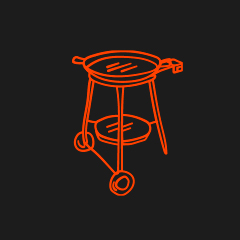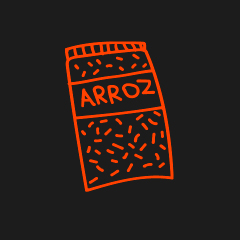WHICH IS THE BEST PAELLA PAN FOR MAKING A PERFECT PAELLA?
WHAT IS THE BEST MATERIAL FOR A PAELLA PAN?
Hello rice lovers, today we’ll look at the main types of paella pans available on the market.
We Valencians refer to "paella" as both the pan and the dish itself. However, in many parts of Spain, it's also called a paellera, a term now accepted by the Royal Spanish Academy due to its widespread use, and therefore it’s also correct to use it to distinguish between the dish and the pan.
Let’s look at the different types of paella pans available:
POLISHED STEEL PAELLA PAN
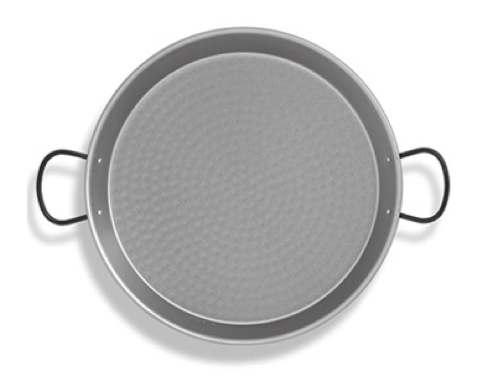
The polished steel paella pan represents the traditional paella. Its main advantage is that, being 100% steel, it conducts heat very quickly and efficiently, making it ideal for achieving the perfect socarrat (crispy rice base). Also, since it contains no additional elements, it is the most affordable paella pan.
The main disadvantage is that it rusts, meaning it requires maintenance. To prevent rust, simply apply a thin layer of vegetable oil after it’s cleaned and dried. It can also be a bit difficult to clean, as food tends to stick to it without a non-stick layer. Using a sufficient amount of oil helps — for a Valencian paella, we recommend 25–30 ml of oil per person.
Another tip is to cook the sofrito (base sauce) over low heat using the inner burners, as overheating can deform the steel. Move larger ingredients to the side once cooked and continue adding the rest.
We stress that steel can deform either during manufacturing or due to overheating. This pan is sensitive to high heat, especially during the sofrito stage. However, once the broth is added, there's no longer a risk, as water boils at 100°C regardless of the flame strength.
ENAMELLED STEEL PAELLA PAN

The enameled steel paella pan is easily recognized by its black color with white speckles. It is essentially the same as the polished steel pan but with a ceramic enamel coating applied in an oven.
This enamel layer is inert and doesn’t affect the flavor of the food. Most importantly, the enamel provides excellent protection against rust, so it requires no maintenance and doesn’t need to be oiled after cleaning. It also makes cleaning easier — just soak it for a couple of hours and scrub it clean.
Avoid scratching or chipping the enamel, as this will compromise its rust-resistant properties. This type of pan costs about 25–30% more than the polished version, but the easy maintenance and durability make it a worthwhile investment.
STAINLESS STEEL PAELLA PAN
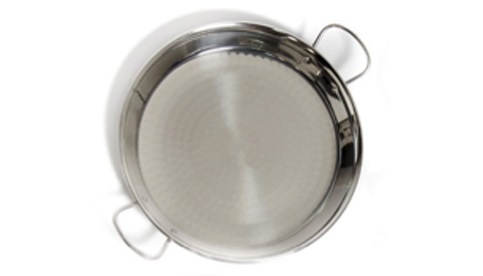
The stainless steel paella pan is known for its shine and durability. It combines the benefits of both previous types — it resembles the traditional polished steel pan but also resists rust like the enameled one, and it’s even resistant to scratches and dents. The only drawback is that it costs 300–500% more than the other pans.
Still, its longevity makes it ideal for professional kitchens — if well maintained, a stainless steel pan can last a lifetime.
EXTRA-THICK PAELLA PAN
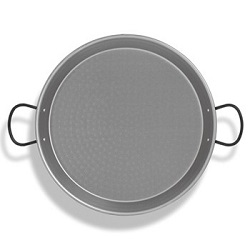
The extra-thick paella pan is just like the polished steel version, with the same pros and cons, but with a thicker base that makes it more resistant. It still requires cleaning and maintenance after each use.
It’s ideal for cooking with wood fire because its thickness prevents warping or cracking under high heat.
MULTI-TASTE OR COMBO PAELLA PAN
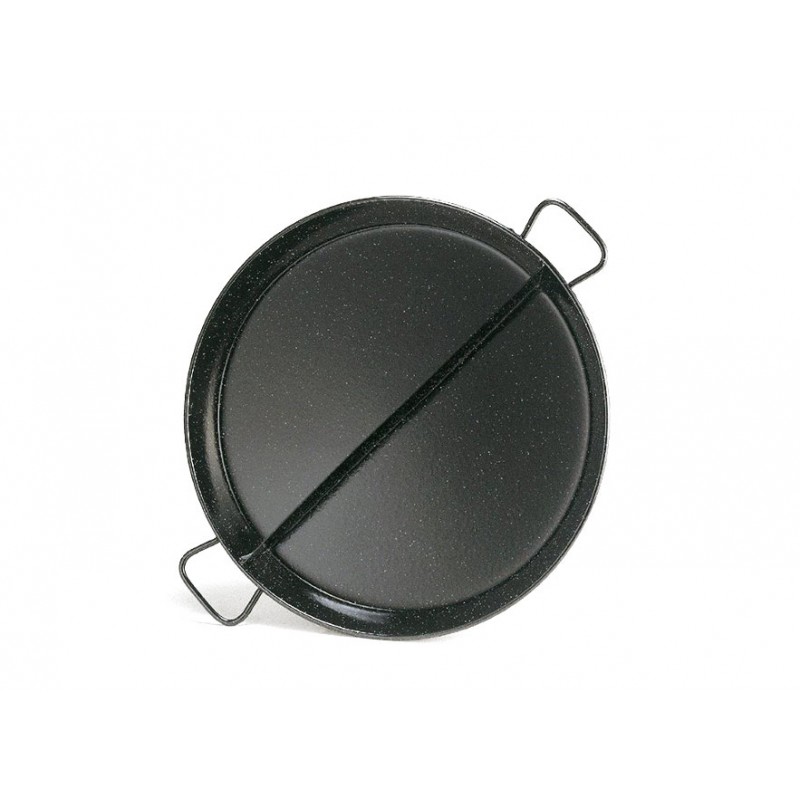
The multi-taste paella pan offers a unique feature not found in other pans: it allows you to cook 2 or 3 different paellas at the same time.
It’s perfect for those who want to try multiple types of paella in one sitting or to cater to different preferences at the same table, so no one misses out on their favorite paella.
Keep in mind that different types of paella may have different cooking times, so plan accordingly for the best results.
WHICH PAELLA PAN IS BEST FOR YOUR NEEDS?
As we've seen, no one paella pan is better than the others — it all depends on the user's needs. Besides the material, it’s important to consider your heat source, as not all pans are compatible with all stoves.
Here’s a guide to which paella pan works best with different types of stoves:
FOR GAS STOVES
Gas stoves are the most versatile, offering good heat control and compatibility with most paella pans. Just make sure the size matches the burner for even heat distribution.
Polished steel pans are ideal for gas stoves, heating quickly and evenly.
Enameled steel pans also work great and require less maintenance.
FOR INDUCTION COOKTOPS
Induction cooking requires a ferromagnetic base — not all paella pans qualify, so this is a key consideration.
There are now specific models in stainless steel with encapsulated bottoms, or enameled steel adapted for induction, that work very well.
Just make sure the surface is perfectly flat, as traditional pans have a slight curvature that can affect contact with induction surfaces.
FOR WOOD FIRES OR OPEN FLAMES
If you’re cooking outdoors or over open flames (e.g. barbecues or wood-fired stoves), you’ll need a pan resistant to extreme heat and direct flame.
Polished or enameled steel pans are best here, as they can handle high temperatures and produce the perfect socarrat.
FOR PROFESSIONAL OR CATERING USE
In professional kitchens where paellas are made frequently or in large batches, the pan must be durable, resilient, and high-capacity.
Extra-thick pans are best suited for this, as they withstand intensive use and temperature changes. They're typically made of polished or enameled steel and often used with industrial gas burners.
WHICH ARE THE BEST PAELLA PANS ON THE MARKET?
As we’ve seen, there are many types of pans and many manufacturers — so you have plenty of options.
Here are some of the most reputable and well-known brands:
Vaello Campos — a leading brand from the Valencian Community, known for polished, enameled, and extra-thick professional pans. They’re sturdy, offer even heat distribution, and are compatible with gas, wood, induction (with proper base), and ceramic stovetops.
El Cid — specializes in handcrafted polished steel pans, ideal for traditional wood or open-flame cooking and appreciated by those who value tradition and a good socarrat.
When it comes to type, the enameled pan is one of the most sought after due to its low maintenance.
WHAT’S THE RIGHT PAELLA PAN FOR YOU?
As we've seen, no single pan is the best — it all depends on your preferences.
The polished steel pan is ideal for traditional cooking, the enameled pan offers convenience with no need for upkeep, the stainless steel pan combines both tradition and ease, the extra-thick pan is best for intense or professional use (especially with wood fires), and finally, the multi-taste pan is great for preparing multiple paellas without needing several pans.
We hope this blog post has helped you choose your perfect paella pan. Best wishes, fellow rice lovers!
If you’d like to read more from our blog, follow this link.

